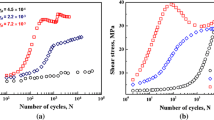Abstract
Microhardness experiments have been performed on faces of olivine single crystals oriented at 45° to the [100] and [001] axis. Experiments have been performed between 20°C and 900°C in order to follow the evolution of the slip systems and the evolution of the nature of dislocations with temperature. Slip systems were identified using interferential contrast, decoration and transmission electron microscopy (TEM). Although the two possible Burgers vectors [001] and [100] are acted upon symmetrically, the only activated slip systems are (100) [001] and {110} [001]. The latter system is less developed and appears only at 600°C and above. Dislocations are mainly [001] screws, which are always very straight. Microcracks are observed together with dislocations. Above 600°C there is a clear relationship between both as a narrow plastic zone is developed around the cracks.
Similar content being viewed by others
References
Carter NC, Ave Lallemant HG (1970) High temperature flow of dunite and peridotite. Geol Soc Am Bull 81:2181–2202
Darot M, Gueguen Y (in press) High temperature creep of forsterite single crystals. J Geophys Res
Durham WB, Goetze C (1977) Plastic flow of oriented single crystals of olivine. I. Mechanical data. J Geophys Res 82:5737–5753
Evans B, Goetze C (1979) The temperature variation of hardness of olivine and its implication for polycrystal yield stress. J Geophys Res 84:5505–5524
Gaboriaud RJ, Boisson M (1978) Plasticité du sesquioxyde d'yttrium Y2O3 par micro-indentation. Rev Phys Appl 13:219–221
Gaboriaud RJ, Denarot MF, Boisson M, Grilhé J (1978) Etude des dislocations par microscopie électronique dans Y2O3 monocristallin déformé plastiquement. Phys Status Solidi (A) 46:387
Gueguen Y (1979) High temperature olivine creep: evidence for control by edge dislocations. Geophys Res Lett 6, 5:357–360
Jaoul O, Gueguen Y, Michaut M, Ricoult D (1979) Decorated dislocations in forsterite. Phys Chem Minerals 5:15–20
Kohlstedt DL, Goetze C, Durham WB, Sande J Van der (1976) New technique for decorating dislocations in olivine. Sciences 191:4231, 1045–1046
Nicolas A, Poirier JP (1976) Crystalline plasticity and solid state flow in metamorphic rocks. Wiley, New York
Phakey P, Dollinger G, Christie J (1972) Transmission electron microscopy of experimentally deformed olivine single crystals. In: Flow and fracture of rocks. Geophys Mon Series 16:117–138
Poirier JP (1975) On the slip systems of olivine. J Geophys Res 80:29, 4054–4061
Poirier JP, Vergobbi B (1978) Splitting of dislocations in olivine, cross slip controlled creep and mantle rheology. Phys Earth Planet Inter 16:370–378
Raleigh CB (1968) Mechanisms of plastic deformation of olivine. J Geophys Res 73:5391–5406
Ricoult D (1979) Experimental annealing of a natural dunite. Bull Mineral 102:86–91
Sande JB Van der, Kohlstedt DL (1976) Observation of dissociated dislocations in deformed olivine. Philos Mag 34:633–658
Westbrook JG, Conrad H (1973) The science of hardness testing and its research application. Am Soc Met in press
Author information
Authors and Affiliations
Rights and permissions
About this article
Cite this article
Gaboriaud, R.J., Darot, M., Gueguen, Y. et al. Dislocations in olivine indented at low temperatures. Phys Chem Minerals 7, 100–104 (1981). https://doi.org/10.1007/BF00309460
Received:
Issue Date:
DOI: https://doi.org/10.1007/BF00309460




